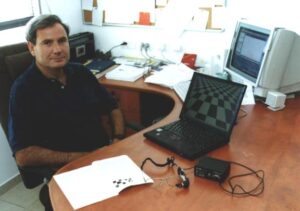Virtual reality helps people with movement disorders walk

An innovative device, developed by Prof. Yoram Baram of the Technion Faculty of Computer Science, uses virtual reality to improve walking in the elderly, as well as in Parkinson’s patients, stroke victims and, more generally, people with movement disorders – possibly reducing their need for medication or surgery.
The apparatus – a small device strapped to the patient’s clothing – displays a tiled floor through a tiny device attached to the patient’s eyeglasses. The tile patterns provide continuous, stabilizing visual information which safeguards against stumbling and falling while walking. The patented innovation is the first of its kind to respond to the patient’s motions rather than just providing a constant visual display.
“The image reacts to the patient’s motions just like in real life,” explains Baram. “For example, when the patient stands in place, the virtual floor doesn’t move, but when he begins to walk, the floor starts moving beneath him. When he turns, the image of the floor also turns. Yet all the while the patient feels like he is walking on a steady floor.”
The idea for the project was sparked 12 years ago while Baram was designing a mechanism for NASA to navigate low-flying helicopters around obstacles such as trees, buildings and electrical poles. The concept of the design, which Baram later applied to the medical device, is that the optical images of objects help the observer stabilize himself in space.
“A person who is walking uses visual images to navigate himself so he doesn’t collide,” says Baram, who earned a bachelor’s degree in aeronautical engineering at Technion, a master’s in aeronautics and astronautics at MIT and a PhD in electrical engineering and computer science at MIT. “While a healthy person has internal mechanisms, such as a liquid in the inner ear, to help balance himself, older people are deficient in this area. But they can be helped by visual cues like tiles that operate through biofeedback.”
Collaborating with Dr. Judith Aharon Peretz, head of the Department of Cognitive Neurology at Rambam Hospital, Baram tested the device on more than 40 patients, ranging in age from 46 to 82. In the study’s first phase, all participants were Parkinson’s patients, but eventually the study also included non-Parkinson’s patients who had suffered strokes and older people who reside in old-age homes in Haifa.
Results were astounding, says Baram, with all patients showing some degree of improvement in their walking. Some experienced drastic improvement similar to the effects of medication or brain surgery, but without the adverse side effects.
The clinical trials indicated that the device may have long-term benefits as well. After using the apparatus for less than 30 minutes only, most patients were able to walk better for a short period of time after they removed the device.
“When I saw these positive results I was amazed, very excited and gratified,” recalls Baram. “After I published a paper on the subject last year, doctors came forward and said they didn’t believe it would work. Of course I had my doubts too. It was a theory that needed to be proven, and we’ve succeeded in doing that.”
Spokesperson Office, Haviva Roger, TL: 04-8235193; Fax: 04-8235195
O. H.
